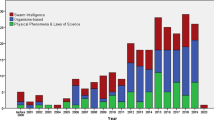Abstract
Nature-inspired algorithms usually use some form of attraction and diffusion as a mechanism for exploitation and exploration. In this paper, we investigate the role of attraction and diffusion in algorithms and their ways in controlling the behavior and performance of nature-inspired algorithms. We highlight different ways of the implementations of attraction in algorithms such as the firefly algorithm, charged system search, and the gravitational search algorithm. We also analyze diffusion mechanisms such as random walks for exploration in algorithms. It is clear that attraction can be an effective way for enhancing exploitation, while diffusion is a common way for exploration. Furthermore, we also discuss the role of parameter tuning and parameter control in modern metaheuristic algorithms and then point out some key topics for further research.
Similar content being viewed by others
References
Arora S, Singh S (2013) The firefly optimization algorithm: convergence analysis and parameter selection. Int J Comput Appl 69(3):48–52
Beyer H-G (1995) Toward a theory of evolution strategies: self-adaptation. Evolut Comput 3(3):311–347
Blum C, Roli A (2003) Metaheuristics in combinatorial optimization: overview and conceptual comparison. ACM Comput Surv 35:268–308
Branke J, Elomari JA (2012) Meta-optimization for parameter tuning with a flexible computing budget. In: Soule T (ed) Proceedings of the 14th Annual Conference on genetic and evolutionary computation (GECCO ‘12). ACM, New York, pp 1245–1252
Burke E, Gendreau K, Hyde M, Kendall M, Ochoa G, Özcan E, Qu R (2013) Hyper-heuristics: a survey of the state of the art. J Op Res Soc 64(12):1695–1724
Črepinšek M, Liu S-H, Mernik M (2013) Exploration and exploitation in evolutionary algorithms: a survey. ACM Comput Surv 45(3):35:1–35:33
Gandomi AH, Yang XS, Alavi AH (2013) Cuckoo search algorithm: a metaheuristic approach to solve structural optimization problems. Eng Comput 29(1):17–35
Goldberg DE (1989) Genetic algorithms in search, optimization and machine learning. Addison Wesley, Reading, Mass
Hanne T (1999) On the convergence of multiobjective evolutionary algorithms. Eur J Op Res 117(3):553–564
Hanne T (2001) Intelligent strategies for meta multiple criteria decision making. Springer, Berlin
Hanne T (2007) A multiobjective evolutionary algorithm for approximating the efficient set. Eur J Op Res 176(3):1723–1734
Kaveh A, Talatahari S (2010) A novel heuristic optimization method: charged system search. Acta Mech 213(3–4):267–289
Kaveh A, Talatahari S (2012) Charged system search for optimal design of frame structures. Appl Soft Comput 12(1):382–393
Kennedy J, Eberhart RC (1995) Particle swarm optimization. In: Proceedings of IEEE International Conference on Neural Networks, Piscataway, pp. 1942–1948
Mantegna RN (1994) Fast, accurate algorithm for numerical simulation of Lévy stable stochastic processes. Phys Rev E 49:4677–4683
Pavlyukevich I (2007) Lévy flights, non-local search and simulated annealing. J Comput Phys 226:1830–1844
Rashedi E, Nezamabadi-pour H, Saryazdi S (2009) GSA: a gravitational search algorithm. Inf Sci 179(13):2232–2248
Rechenberg I (1973) Evolutionsstrategie: Optimierung technischer Systeme nach Prinzipien der biologischen Evolution (Evolution strategy: optimization of technical systems based on concepts from biological evolution). Fromman-Holzboog, Stuttgart
Talatahari S, Jahani Y (2015) Hybrid charged system search-particle swarm optimization for design of single-layer barrel vault structures. Asian J Civil Eng 16(4):515–533
Tan KC, Goh CK, Yang YJ, Lee TH (2006) Evolving better population distribution and exploration in evolutionary multi-objective optimization. Eur J Op Res 171(2):463–495
Tan KC, Chiam SC, Mamun AA, Goh CK (2009) Balancing exploration and exploitation with adaptive variation for evolutionary multi-objective optimization. Eur J Op Res 197(2):701–713
Yang XS (2008) Nature-inspired metaheuristic algorithms. Luniver Press, Bristol
Yang XS (2008) Introduction to computational mathematics. World Scientific Publishing, Singapore
Yang XS (2009) Firefly algorithms for multimodal optimization. In: Watanabe O, Zeugmann T (eds) Proceedings of 5th Symposium on Stochastic Algorithms, Foundations and Applications, SAGA 2009, Springer, Heidelberg, pp. 169–178
Yang XS (2011) Metaheuristic optimization: algorithm analysis and open problems. In: Pardalos PM, Rebennack S (eds) Experimental algorithms. Springer, Berlin, pp 21–32
Yang XS, Deb S (2009) Cuckoo search via Lévy flights. In: Proceedings of world congress on nature and biologically inspired computing (NaBIC 2009, India), IEEE Publications, USA, pp. 210–214
Yang XS, Deb S (2010) Engineering optimization by cuckoo search. Int J Math Model Numer Optim 1(4):330–343
Yang XS, Deb S (2010) Eagle strategy using Lévy walk and firefly algorithms for stochastic optimization. Nature inspired cooperative strategies for optimization (NICSO 2010). Springer, Berlin, pp 101–111
Yang XS, Deb S (2012) Two-stage eagle strategy with differential evolution. Int J Bio-Inspir Comput 4(1):1–5
Yang XS, Deb S, Fong S (2011) Accelerated particle swarm optimization and support vector machine for business optimization and applications. Networked digital technologies (NDT2011), communications in computer and information science, vol 136. Springer, Berlin, pp 53–66
Yang XS, Gandomi AH (2012) Bat algorithm: a novel approach for global engineering optimization. Eng Comput 29(5):464–483
Yazdani S, Nezamabadi-pour H, Kamyab S (2014) A gravitational search algorithm for multimodal optimization. Swarm Evolut Comput 14(1):1–14
Author information
Authors and Affiliations
Corresponding author
Rights and permissions
About this article
Cite this article
Yang, XS., Deb, S., Hanne, T. et al. Attraction and diffusion in nature-inspired optimization algorithms. Neural Comput & Applic 31, 1987–1994 (2019). https://doi.org/10.1007/s00521-015-1925-9
Received:
Accepted:
Published:
Issue Date:
DOI: https://doi.org/10.1007/s00521-015-1925-9




